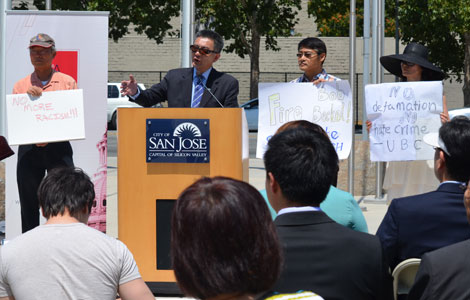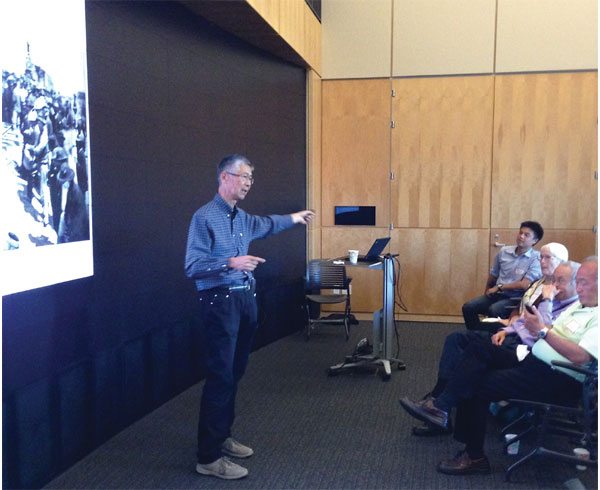Stanford project sheds lights on lives of Chinese railway workers
Updated: 2014-07-31 11:13
By Lian Zi in San Francisco (China Daily USA)
|
||||||||
|
Gordon Chang (left), co-director of the Chinese Railroad Workers in North America project, presents the research update to more than 60 Stanford and Princeton alumni at Stanford University in California on Tuesday. Provided to China Daily |
Chinese Railroad Workers in North America, an online digital archive that commemorates the work of thousands of Chinese immigrants in building the Transcontinental Railroad and seeks "to give a voice" to them, was unveiled at Stanford University earlier this week.
The project is the result of Stanford University scholars collaborating with historians, investigators and archeologists in China and the United States who delved into the biographies, daily habits and social lives of the Chinese railroad workers. They also conducted interviews with the workers' descendants to learn about their individual family stories.
Stanford Professor Gordon Chang, co-director of the project, shared research findings at the university on Tuesday night with about 60 attendees, and elaborated on the important role early Chinese immigrants played in helping the US lay the foundation for one of its most important infrastructures.
"This project aims at recovering the experiences of (Chinese) railroad workers who came to the US, and knowing about how they lived and worked; how they suffered and triumphed over adversity," Chang told China Daily. "The public may know the involvement of Chinese railroad workers in building this incredible infrastructure, but don't know about their lives. They have never received the attention they deserve."
Shelley Fisher Fishkin, another co-director of the project and director of Stanford's American Studies program, said the contributions of Chinese immigrant railway workers "is an important chapter of history that was unjustly forgotten".
From 1865 to 1869, 10,000 to 15,000 Chinese immigrants were involved in building what would become the first transportation network to connect the entire US. Opened in 1869, the railroad revolutionized the settlement and economy of the American West by bringing the Western states into the whole country and making transportation much quicker and cheaper.
Working conditions of those Chinese immigrants were challenging, and they only received minimal monthly wages of $24 to $31, said Fisher Fishkin.
Historians estimate that around 50 to 150 Chinese workers died from avalanches and landslides, as well as from worksite accidents, according to a report on the project's website.
After completion of the railway, some of the Chinese workers chose to return to China, while others stayed in the US and worked in agriculture, mining, building levees along rivers or tried their luck in the Chinatowns in Sacramento, San Francisco, and the small towns in the Sierras Nevada mountains, according to the project.
Stanford University would not exist without the labor of these Chinese workers who built the railroad and created the wealth that Leland Stanford used to found Stanford University, Fisher Fishkin explained.
Scholars and researchers who worked on the project received support from China and the US, said Chang, adding, "We have already found archives and libraries to share and preserve these invaluable materials in China."
Chang, a professor in Humanities and American History at Stanford, conducted the project mainly with Fisher Fishkin, Evelyn Hu-Dehart, professor of history and ethnic studies at Stanford; and Dongfang Shao, chief of the Asian division of the Library of Congress.
zilian@chinadailyusa.com
(China Daily USA 07/31/2014 page2)

 Jobs hunting
Jobs hunting
 Happy homecoming for retired ambassador
Happy homecoming for retired ambassador
 New York state seeks Chinese tourists
New York state seeks Chinese tourists
 Leadership foundation brings young ambassadors to DC
Leadership foundation brings young ambassadors to DC
 Panda North American film festival opens for submissions
Panda North American film festival opens for submissions
 Lavender farm has right scent to lure Chinese tourists
Lavender farm has right scent to lure Chinese tourists
 Pleas for help on murder case
Pleas for help on murder case
 Silicon Valley rally calls on Fox News to fire Beckel
Silicon Valley rally calls on Fox News to fire Beckel
Most Viewed
Editor's Picks

|

|

|

|

|

|
Today's Top News
Multinational bribery cases on the rise
Alibaba's stake in Snapchat may buoy mobile portfolio
'Military drill isn't targeting any nation'
Reforming hukou will unify rights of migrants
Oil stocks rally on news of probe
Firm to build $1.85bn plant in US
Microsoft responds to anti-monopoly probe
Alibaba reportedly to fund Snapchat
US Weekly

|

|







